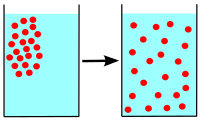
Photo from wikipedia
Like and oppositely charged particles or dust grains in linear shear flows are often driven to collide with one another by fluid and/or electrostatic forces, which can strongly influence particle-size… Click to show full abstract
Like and oppositely charged particles or dust grains in linear shear flows are often driven to collide with one another by fluid and/or electrostatic forces, which can strongly influence particle-size distribution evolution. In gaseous media, collisions in shear are further complicated because particle inertia can influence differential motion. Expressions for the collision rate coefficient have not been developed previously which simultaneously account for the influences of linear shear, particle inertia, and electrostatic interactions. Here, we determine the collision rate coefficient accounting for the aforementioned effects by determining the collision area, i.e., the area of the plane perpendicular to the shear flow defining the relative initial locations of particles which will collide with one another. Integration of the particle flux over this area yields the collision rate. Collision rate calculations are parametrized as an enhancement factor, i.e., the ratio of the collision rate considering potential interactions and inertia to the traditional collision rate considering laminar shear only. For particles of constant surface charge density, the enhancement factor is found dependent only on the Stokes number (quantifying particle inertia), the electrostatic energy to shear energy ratio, and the ratio of colliding particle radii. Enhancement factors are determined for Stokes numbers in the 0-10 range and energy ratios up to 5. Calculations show that the influences of both electrostatic interactions and inertia are significant; for inertialess (St=0) equal-sized and oppositely charged particles, we find that even at energy ratios as low as 0.2, enhancement factors are in excess of 2. For the same situation but like-charged particles, enhancement factors fall below 0.5. Increasing the Stokes number acts to mitigate the influence of electrostatic potentials for both like and oppositely charged particles; i.e., inertia reduces the enhancement factor for oppositely charged particles and increases it for like-charged particles. Uniquely, at elevated Stokes numbers with attractive potentials we find collisionless "pockets" within the collision area, which are regions completely bounded by the collision area but within which collisions do not occur. Regression equations to results are provided, enabling calculation of the enhancement factor as a function of energy ratio and Stokes number. In total, this study both leads to insight into the collision dynamics of finite-inertia, charged particles in shear flows, and provides a means to simply calculate the particle-particle collision rate coefficient.
Journal Title: Physical Review E
Year Published: 2017
Link to full text (if available)
Share on Social Media: Sign Up to like & get
recommendations!